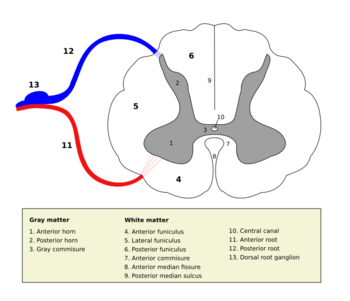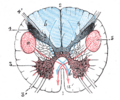Biology:Posterior grey column
| Posterior grey column (Posterior horn of spinal cord) | |
|---|---|
 Cross section of the spinal cord. The posterior horn is the upper protrusion of grey matter, labeled with "2" | |
| Details | |
| Identifiers | |
| Latin | cornu posterius medullae spinalis |
| Anatomical terminology | |
The posterior grey column (posterior cornu, dorsal horn, spinal dorsal horn, posterior horn, sensory horn[1]) of the spinal cord is one of the three grey columns of the spinal cord.[citation needed] It is a pronounced, dorsolaterally-oriented ridge of gray matter in either lateral half of the spinal cord. When viewed in transverse section, it is termed the posterior horn or dorsal horn.[2]
The posterior column contains the cell bodies of second-order sensory neurons and their synapses with the pseudounipolar first-order sensory neurons (whose cell bodies are located within the sensory ganglia (a.k.a. dorsal root ganglia)). It receives several types of sensory information from parts of the body (including fine touch, proprioception, and vibration) from receptors of in the skin, bones, and joints.[citation needed]
Anatomy
The posterior horn extends to the surface of the spinal cord.[3]
Structure
The posterior grey column is subdivided into six layers termed Rexed laminae I-VI
- Marginal nucleus of spinal cord (lamina I)
- Substantia gelatinosa of Rolando (lamina II)
- Nucleus proprius (laminae III, IV)
- Spinal lamina V, the neck of the posterior horn[4]
- Spinal lamina VI, the base of the posterior horn.
The other four Rexed laminae are located in the other two grey columns in the spinal cord.
Additional images
Function
Posterior horn of spinal cord involves in sensory processing.
The function of the spinal dorsal horn is to process and integrate sensory information from the peripheral nervous system. It receives inputs from primary afferent fibers and modulatory systems, and it projects to higher brain centers and motor neurons. The dorsal horn circuitry is involved in various aspects of sensory processing, including discrimination, integration, and modulation of nociceptive and non-nociceptive signals. Dysfunction of the dorsal horn circuitry has been implicated in chronic pain conditions and other neurological disorders[5].
See also
- Posterior column-medial lemniscus pathway
- Posterior horn of lateral ventricles
- Anterior grey column
References
- ↑ "Dorsal horn | anatomy" (in en). https://www.britannica.com/science/dorsal-horn.
- ↑ "columna posterior". https://medical-dictionary.thefreedictionary.com/columna+posterior.
- ↑ Sinnatamby, Chummy S. (2011). Last's Anatomy (12th ed.). Elsevier Australia. pp. 487. ISBN 978-0-7295-3752-0.
- ↑ Woolsey, Robert M.; Vernon W. Lin; Cardenas, Diana D.; Cutter, Nancy C.; Frederick S. Frost; Margaret C. Hammond; Laurie B. Lindblom; Inder Perkash et al. (2002). Spinal Cord Medicine: Principles and Practice. Demos Medical Publishing. ISBN 1-888799-61-7.
- ↑ Harding, Erika K.; Fung, Samuel Wanchi; Bonin, Robert P. (2020). "Insights Into Spinal Dorsal Horn Circuit Function and Dysfunction Using Optical Approaches". Frontiers in Neural Circuits 14. doi:10.3389/fncir.2020.00031. ISSN 1662-5110. PMID 32595458.
 |


